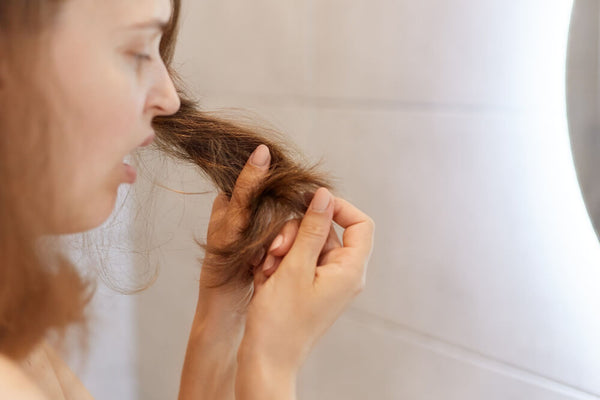That first time you see yourself with a perfectly filled-in hairline in the mirror—it hits you right in the heart. After years of thinning edges and a widening part, you finally look like the you, you remember. Scalp Micropigmentation (SMP) promises that instant transformation and the emotional lift is real.
But then a question pops up in the back of your mind: "Does this actually fix my hair in any way? Or did it just cover up the problem?"
It's a question we hear from so many women in our Atlanta practice. They're torn between that immediate cosmetic fix and the deeper desire for their own, real hair to grow back. Let's walk through what SMP really is, so you can make a choice you feel good about for years to come.
How Does Scalp Micropigmentation Actually Work on Thinning Hair?
SMP is just like the most advanced form of cosmetic tattooing for your scalp. A technician uses tiny needles to deposit pigment into the dermis. This creates thousands of microscopic dots that just look like shaved hair follicles on your head.
It can create the illusion of density on a thinning crown or draw a crisp, new hairline where yours has receded. For some, it's a tool to camouflage scars from old injuries or even previous hair transplant procedures.
The result is immediate. There's no waiting for growth. You walk out of the clinic looking like you have a fresh, full buzz cut. For women, technicians often use softer, more natural patterns to replicate the appearance of hair follicles beneath existing hair.
What Are the Real Risks Nobody Talks About for Black Skin?
Any time you introduce pigment into skin, there are risks. For melanated skin, these risks are even more important to consider.
-
Keloid Formation: If you're prone to keloids, puncturing your scalp thousands of times could trigger a serious reaction, turning your SMP into a raised, textured scar.
-
Pigment Discoloration: Ink can fade to a blue, green, or ashy hue over time, which stands out starkly against dark skin. What looks like a perfect match today might not in five years.
-
Poor Technique: An inexperienced artist might create dots that are too large, too deep, or placed in an unnatural pattern. You'll be sadly left with a helmet-head look that screams "tattoo" instead of "hair."
-
It's a Cover-Up, Not a Cure: This is the biggest risk of all. SMP does nothing to address the underlying cause of your hair loss. That case of CCCA or hormonal thinning will continue to progress underneath the pigment.
Can SMP Work With Conditions Like CCCA or Traction Alopecia?
This is a tricky one. SMP can visually mask the early stages of these conditions and can hence make your scalp look full again in a way. But it's like putting a beautiful bandage on a wound that's still bleeding underneath.
For CCCA, the inflammation is still actively destroying your follicles. For traction alopecia, the constant tension is still damaging your follicles. SMP doesn't stop that process. In fact, by giving you a false sense of security, it might make you delay the real medical treatments that could actually save your hair.
If you have an active, inflammatory scalp condition, getting SMP could even worsen irritation and lead to poor pigment retention or more scarring.
How Long Does SMP Actually Last Before It Fades?
They call it "semi-permanent" for a reason. Most providers will tell you it lasts 3-5 years. The truth is, your body is constantly breaking down and absorbing that foreign pigment. Sun exposure, your skin type, and even your immune system cause it to fade.
This means you're looking at a lifetime of touch-up appointments—and lifetime costs—to maintain the look. It's not a one-time purchase; it's a recurring subscription to your appearance.
What's the Difference Between SMP and Actually Regrowing Your Hair?
This is the core of the decision. It's the difference between art and science.
SMP is an Illusion. It's a cosmetic art project on your scalp. It changes how your hair looks to other people.
Hair Restoration is a Science. It's a biological process of healing your scalp, reviving your follicles, and growing your actual hair back. It changes how your hair actually is.
At Nina Ross Hair Therapy, we focus on the science. Our treatments like PRP Therapy and Exosome Therapy use your body's own growth factors. They are generally used to wake up your dormant follicles and stimulate new growth.
It's slower than SMP but you’ll grow your own living, breathing hair.
So When Does SMP Actually Make Sense?
We're not here to completely dismiss SMP. In certain situations, it can be a useful tool in a larger hair restoration strategy.
It might make sense for you if:
-
You have stable hair loss and extensive scarring that won't support new growth.
-
You've already maximized your hair regrowth with medical treatments and want to add extra density.
-
You fully understand it's a cosmetic cover-up and are also committed to a treatment plan to maintain the hair you have.
The worst reason to get SMP? Because you feel you've run out of other options and have lost all hope for your real hair.
Book Your Hair Evaluation Today
Before you commit to a lifetime of tattoos, isn't it worth exploring if your own hair can still grow? At Nina Ross Hair Therapy, we specialize in finding that hope. We've helped countless women who thought they were "out of options" regrow their hair by addressing the root cause. Book your $99 Hair Therapy Evaluation today.
Let's look at your scalp together and give you an honest answer about what's truly possible for your hair.














